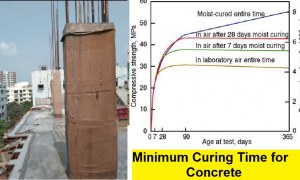🕑 Reading time: 1 minute
Reinforced concrete structures in coastal areas are subjected to an extremely corrosive environment. This is due to the presence of chloride ions in the seawater. The presence of oxygen exacerbates the aggressive condition in coastal areas especially in zones subject to sea spray and splash.
Corrosion of reinforcing steel is one of the most important causes of deterioration of concrete structures in the coastal environment. High permeability concrete, poor design detailing and construction defects such as inadequate depth of cover allow the ingress of salt and moisture into the concrete. A high concentration of salt and moisture results in accelerated corrosion of reinforcing steel thereby significantly deteriorating the concrete structure.
That is why necessary measures should be considered to protect reinforced concrete structures in coastal areas. For instance, use blast furnace slag to improve concrete permeability, use high-quality construction materials, compact concrete properly, utilize proper curing regime, consider various attacking sources in the soil which are in direct contact with the structure.
Classification of Coastal Structure
Based on Exposure Conditions
Concrete structures in coastal areas can be divided into two categories based on their exposure Conditions:
1. Direct Exposure
Direct exposure includes structures that are fully or partially submerged.

2. Indirect Exposure
Indirect exposure includes structures that do not come into direct contact with seawater. Buildings along the coastline are examples of indirect category of exposure.

Based on Vis-a-vis Corrosion
Concrete structures in coastal areas can be distinguished vis-à-vis corrosion:
1. Submerged Zone (Under Seawater)
Corrosion of reinforced concrete structures in submerged zone is restricted by low oxygen availability and conversely lowers chloride and moisture content.
2. Splash and Tide Zone (Intermittently Wet and Dry)
Structures constructed in splash and tide zone suffer severe corrosion because alternate wetting and drying result in high chloride and oxygen content.
3. Atmospheric Zone (Well Above the High Tide Level)
Atmospherically exposed reinforced concrete buildings are subjected to corrosion from airborne salts and moisture from atmosphere. The quality of the concrete and the depth of cover play a major role in the ingress of chloride
Factors Influencing Corrosion Rate
Corrosion is commonly associated with deposition of sea salt in the presence of moisture on steel and light metals. Chloride is the most significant corrosive species in the salt particles. Corrosion of structures in coastal areas is influenced by several factors which are presented below:
- Quantity of salt on the metal surface which is also related to speed and direction of wind.
- Distance between the structure and the shore.
- Elevation of RCC structure
- Degree of sheltering.
- Frequency and amount of rain washing.
- Time of wetness.
- Relative humidity
- Metal surface temperature.
Protection Strategies
1. Using Ground Granulated Blast Furnace Slag (GGBS) with Portland cement
Normal steel has poor resistance in the coastal atmosphere and hence requires protection for durability. Impermeable and dense concrete is required to be constructed in order to impede the penetration of chloride ions. This can be achieved by using Ground Granulated Blast Furnace Slag (GGBS) with Portland cement.
Based on IS 456:2000 recommendation, “where chloride is encountered along with sulphates in soil or groundwater, Ordinary Portland Cement with C3A content from 5 to 8 per cent shall be desirable to be used in concrete, instead of sulphate resisting cement. Alternatively, Portland slag cement conforming to IS 455 having more than 50 per cent slag or a blend of Ordinary Portland Cement and slag cement may be used provided sufficient information is available on the performance of such blended cements in these conditions".
There are several requirements that need to be considered before the use of Pozzolana Cement (GGBS):
- Design the mix for target strength after testing the cement.
- Control the water-cement ratio as low as possible by making use of plasticizers.
- Assure profuse curing for a longer time, say, 14 days.
- Wait for centering removal till the concrete attains twice the strength required to resist the stresses that will be produced in the concrete while removing the centering. This is normally 1.5 times the usual centering removal period for OPC. However, the same can be determined from cube test results.
2. Use High Quality Materials
To achieve low permeability, concrete must be dense with a good bond between aggregate and cement paste. This can be achieved by using good standard quality materials required to make quality concrete with adequate cement content, a low water-cement ratio and small-sized well-graded aggregates. Admixtures containing chlorides should not be used as they promote corrosion of reinforcement.
Apart from the use of high-quality materials, it is necessary to study the corrosion potential of soils which can be judged from soil chemistry, pH value of soil, soil mineral composition, the effect of groundwater, subsoil temperature, microbial activity in soil oxidizing or reducing capacity of soil.
The effect of corrosion potential of the soil is to either attack concrete or make it weak or to corrode the reinforcement in the structural members.
3. Meet Requirements of IS 456 Regarding Concrete Mixture
Based upon the environmental exposure conditions, requirements of IS 456:2000 for minimum cement content, maximum W/C Ratio, minimum grade of concrete, nominal weight aggregates of 20mm nominal maximum size, and minimum concrete cover for durability and fire resistance should be complied with.
4. Proper Concrete Compaction
Proper compaction of concrete is of vital importance in minimizing permeability. Problems may arise when placing and vibrating techniques are incorrect, slump is too low, reinforcement is congested or form shapes are not conducive to the necessary flow of concrete during placement.
5. Adequate and Proper Curing of Concrete
Proper and sufficient curing of concrete is essential to achieve low permeability as the continued hydration of cement increases the volume of the gel and hence decreases pore spaces and blocks capillaries.


